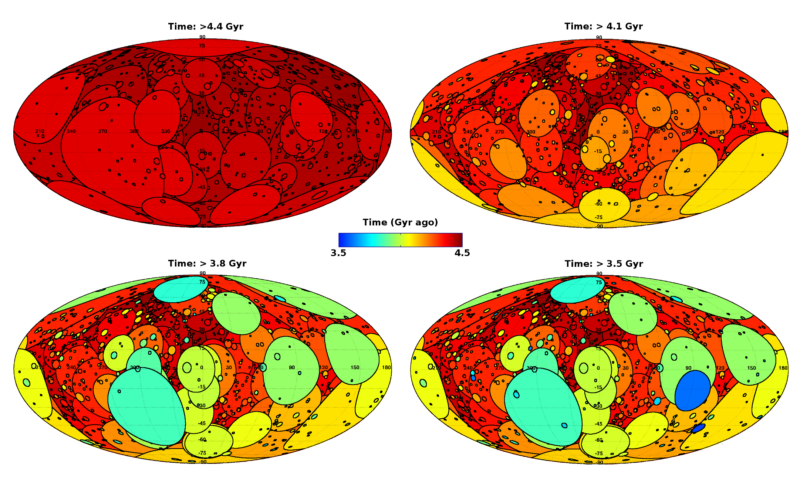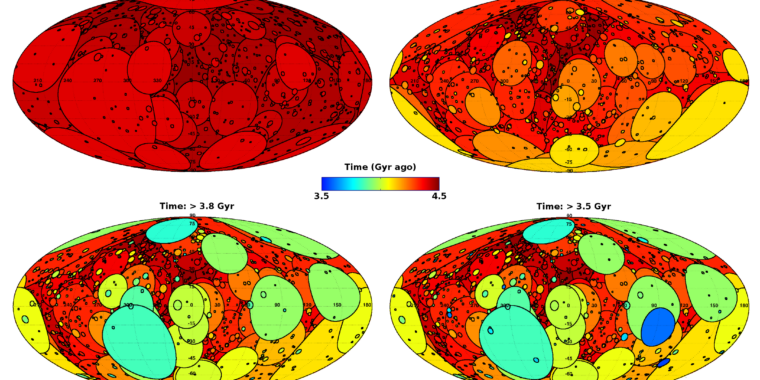What would the late heavy bombardment have done to the Earth’s surface?
Under fire —
Early in Earth’s history, bombardment by enormous asteroids was common.

Enlarge / Each panel shows the modeled effects of early Earth’s bombardment. Circles show the regions affected by each impact, with diameters corresponding to the final size of craters for impactors smaller than 100 kilometers in diameter. For larger impactors, the circle size corresponds to size of the region buried by impact-generated melt. Color coding indicates the timing of the impacts. The smallest impactors considered in this model have a diameter of 15 kilometers.
Simone Marchi, Southwest Research Institute
When it comes to space rocks slamming into Earth, two stand out. There’s the one that killed the dinosaurs 65 million years ago (goodbye T-rex, hello mammals!) and the one that formed Earth’s Moon. The asteroid that hurtled into the Yucatan peninsula and decimated the dinosaurs was a mere 10 kilometers in diameter. The impactor that formed the Moon, on the other hand, may have been about the size of Mars. But between the gigantic lunar-forming impact and the comparatively diminutive harbinger of dinosaurian death, Earth was certainly battered by other bodies.
At the 2023 Fall Meeting of the American Geophysical Union, scientists discussed what they’ve found when it comes to just how our planet has been shaped by asteroids that impacted the early Earth, causing everything from voluminous melts that covered swaths of the surface to ancient tsunamis that tore across the globe.
Modeling melt
When the Moon-forming impactor smashed into Earth, much of the world became a sea of melted rock called a magma ocean (if it wasn’t already melted). After this point, Earth had no more major additions of mass, said Simone Marchi, a planetary scientist at the Southwest Research Institute who creates computer models of the early Solar System and its planetary bodies, including Earth. “But you still have this debris flying about,” he said. This later phase of accretion may have lacked another lunar-scale impact, but likely featured large incoming asteroids. Predictions of the size and frequency distributions of this space flotsam indicate “that there has to be a substantial number of objects larger than, say, 1,000 kilometers in diameter,” Marchi said.
Unfortunately, there’s little obvious evidence in the rock record of these impacts before about 3.5 billion years ago. So scientists like Marchi can look to the Moon to estimate the number of objects that must have collided with Earth.
Armed with the size and number of impactors, Marchi and colleagues built a model that describes, as a function of time, the volume of melt this battering must have produced at the Earth’s surface. Magma oceans were in the past, but impactors greater than 100 kilometers in diameter still melted a lot of rock and must have drastically altered the early Earth.
Unlike smaller impacts, the volume of melt generated by objects of this size isn’t localized within a crater, according to models. Any crater exists only momentarily, as the rock is too fluid to maintain any sort of structure. Marchi compares this to tossing a stone into water. “There is a moment in time in which you have a cavity in the water, but then everything collapses and fills up because it’s a fluid.”
The melt volume is much larger than the amount of excavated rock, so Marchi can calculate just how much melt might have spilled out and coated parts of the Earth’s surface with each impact. The result is an astonishing map of melt volume. During the first billion years or so of Earth’s history, nearly the entire surface would have featured a veneer of impact melt at some point. Much of that history is gone because our active planet’s atmospheric, surface, and tectonic processes constantly modify much of the rock record.
Balls of glass
Even between 3.5 and 2.5 billion years ago, the rock record is sparse. But two places, Australia and South Africa, preserve evidence of impacts in the form of spherules. These tiny glass balls form immediately after an impact that sends vaporized rock skyward. As the plume returns to Earth, small droplets begin to condense and rain down.
Enlarge / Spherule bed from impact S3 in drill core. Here, S3’s spherule beds were deposited in deep enough water to not be diluted by other detritus.
Nadja Drabon, Harvard
“It’s remarkable that we can find these impact-generated spherule layers all the way back to 3.5 billion years ago,” said Marchi.
What would the late heavy bombardment have done to the Earth’s surface? Read More »
